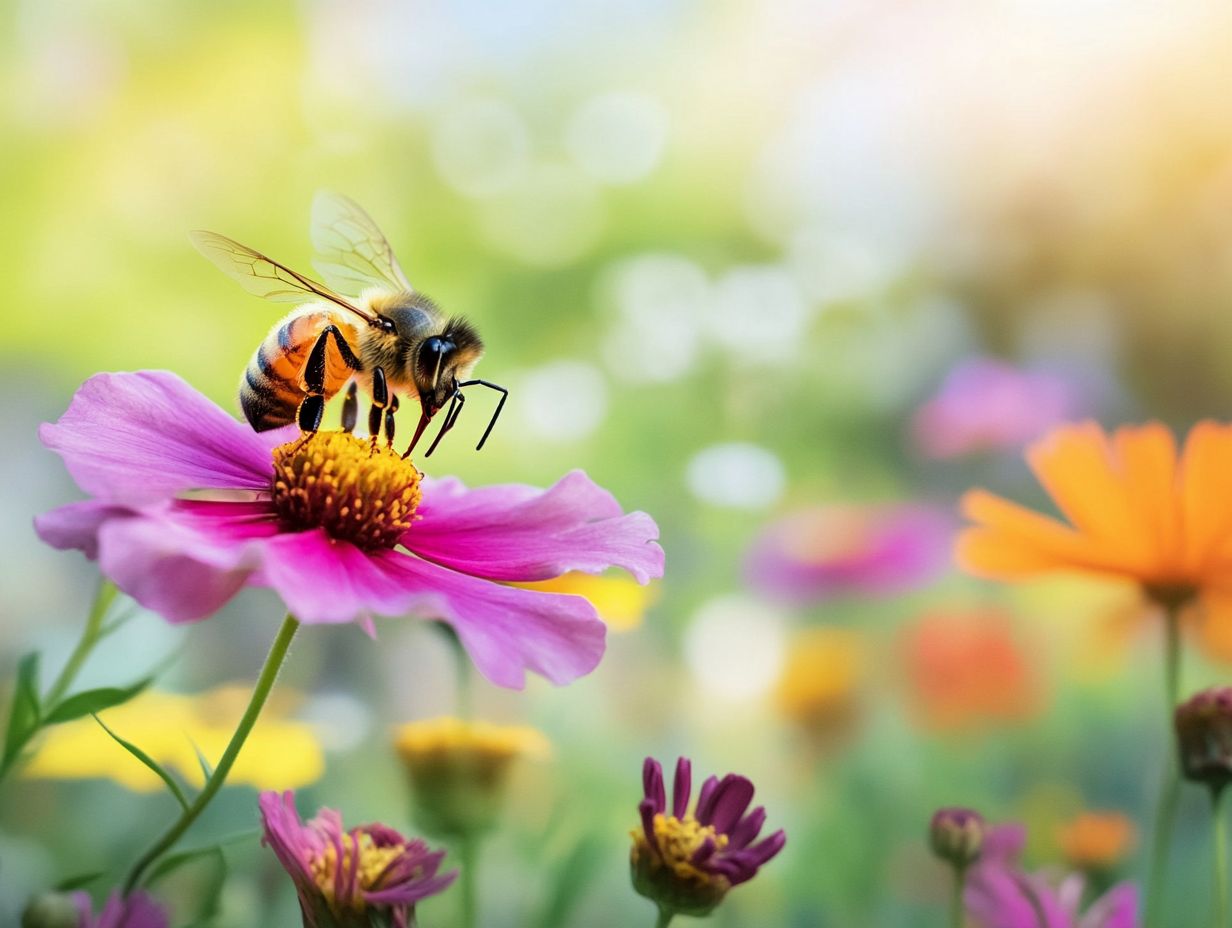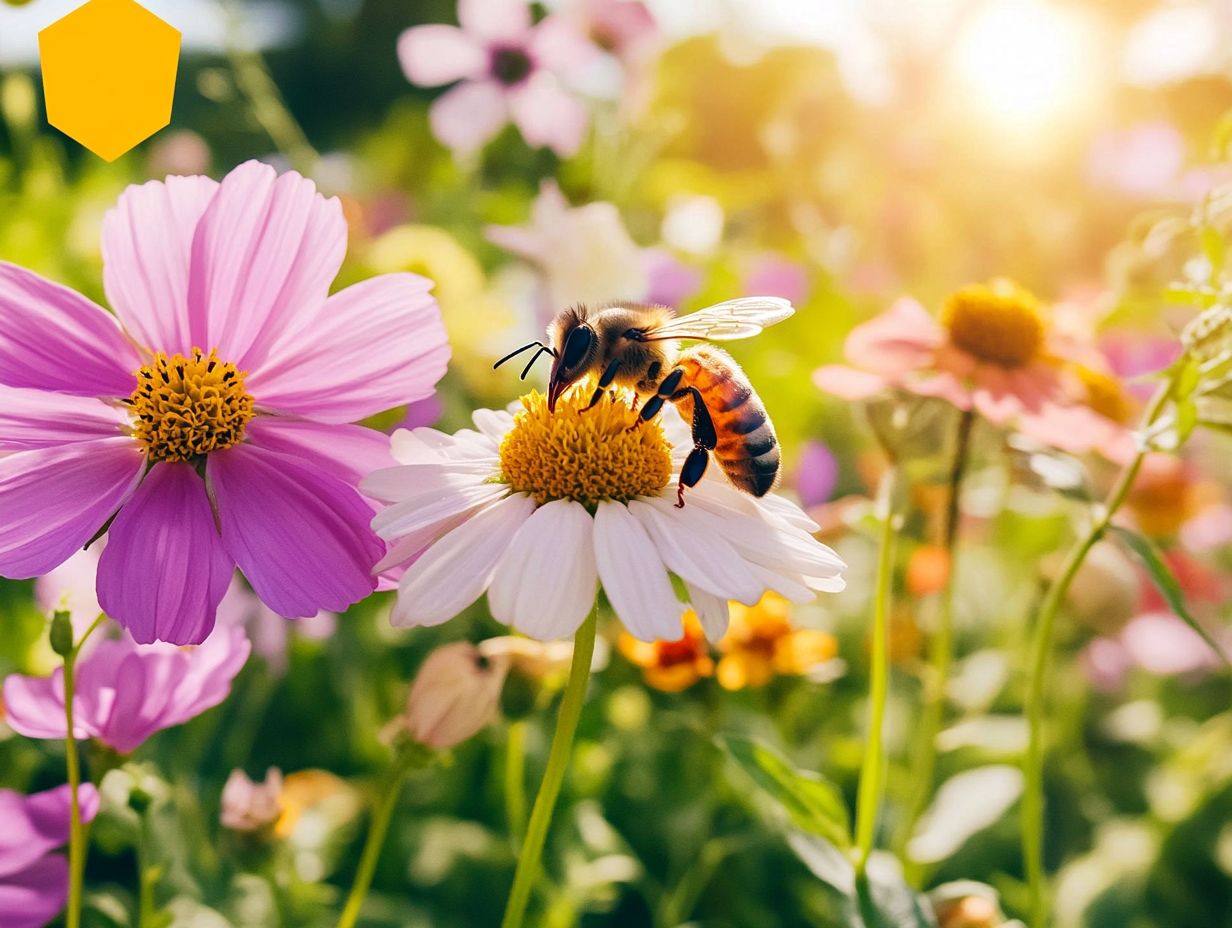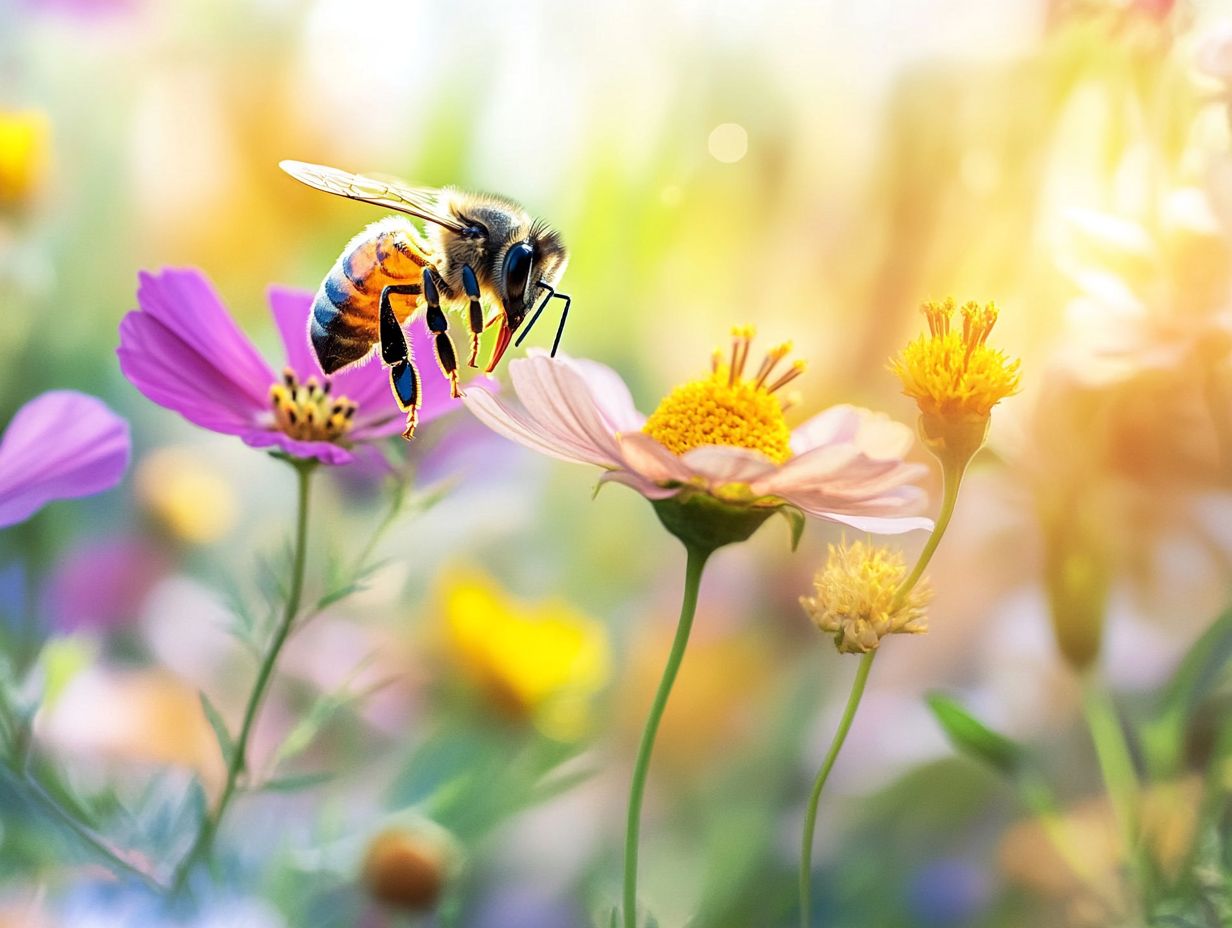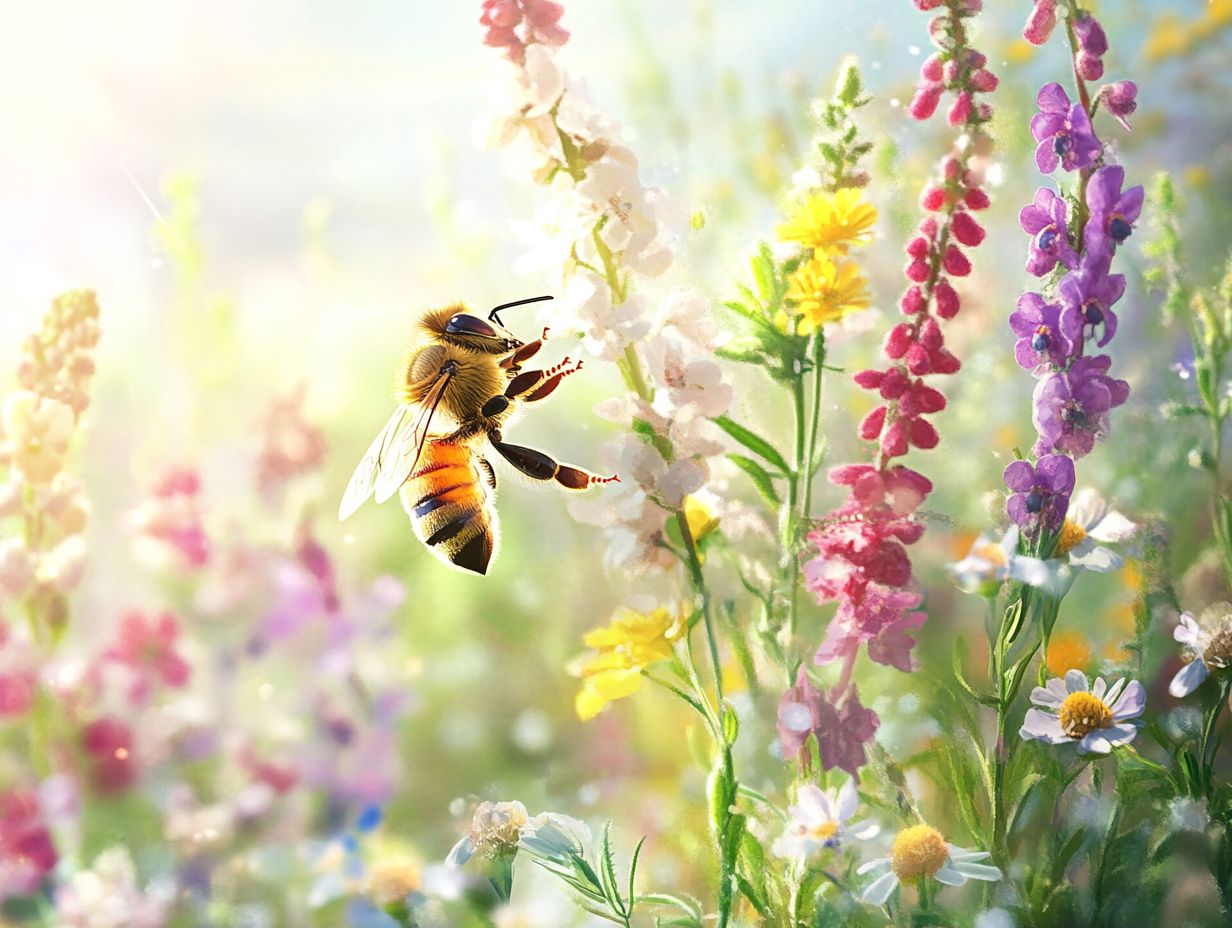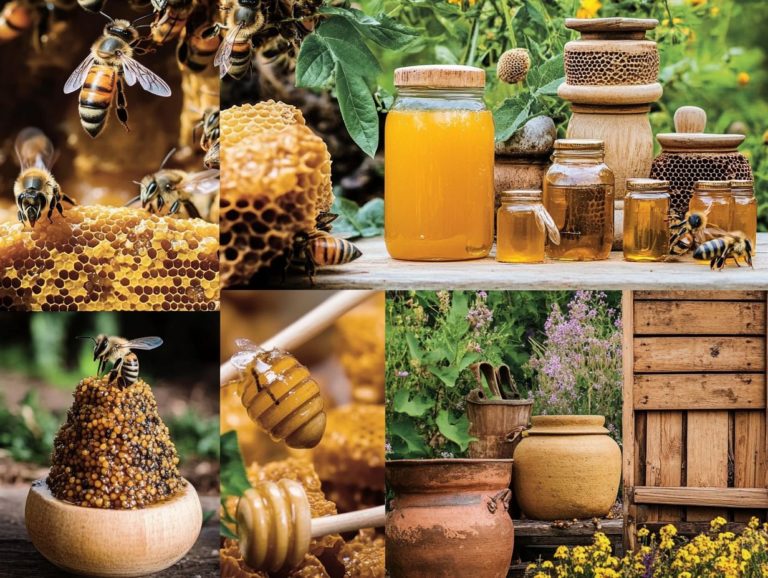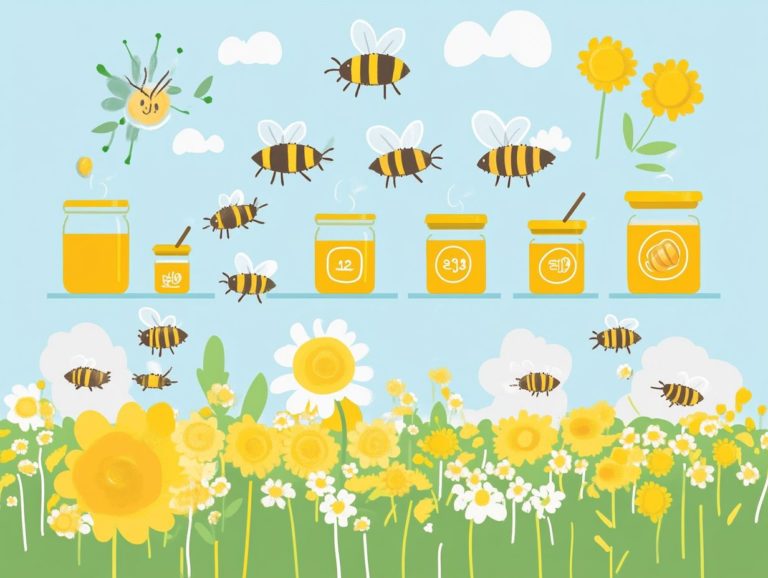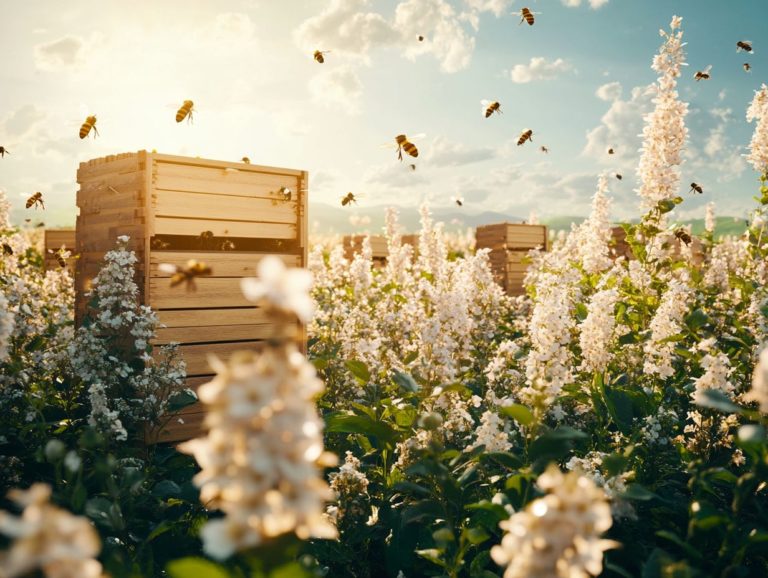The Importance of Floral Sources in Honey Production
Honey is more than a delightful treat. It is shaped by the flowers from which bees gather nectar, showcasing the diversity of nectar plants in different regions.
To appreciate honey, explore its types. Raw honey, Manuka honey, and clover honey each offer distinct flavors.
This article highlights the challenges of supporting local beekeepers and embracing sustainable practices in honey production.
Contents
- Key Takeaways:
- What is Honey Production?
- What Are the Different Types of Honey?
- What Are Floral Sources in Honey Production?
- Why Are Floral Sources Important in Honey Production?
- What Are the Challenges in Using Specific Floral Sources for Honey Production?
- How Can Consumers Support Sustainable Floral Sources in Honey Production?
- Frequently Asked Questions
- What is the role of floral sources in honey production?
- How do floral sources affect the taste and color of honey?
- Why is it important for beekeepers to consider floral sources?
- Can the availability of floral sources impact honey production?
- How does the use of pesticides on floral sources affect honey production?
- Do different types of floral sources produce different types of honey?
Key Takeaways:
- Floral sources play a crucial role in honey production, impacting its taste, color, nutritional value, and sustainability.
- Climate, weather, and pesticide use can affect floral sources and honey production, posing risks for honeybees and biodiversity.
- Consumers can support sustainable floral sources by choosing local and responsibly sourced honey and by supporting beekeepers who prioritize ecological practices.
What is Honey Production?
Honey production is a fascinating process driven by bees, especially the hardworking Apis mellifera. These bees gather nectar from various flowers, creating honey and supporting vital pollination efforts.
This activity enhances biodiversity and supports sustainability in ecosystems. In Brazil, beekeepers manage hives to produce different honey types, showing the link between agriculture and nature.
What Are the Different Types of Honey?
Honey can be categorized by floral sources and production methods, including raw honey, Manuka honey, and clover honey. Each type reflects its unique nectar origins.
By understanding these distinctions, you can make informed choices while appreciating the essential role of plants in supporting pollination.
What is Raw Honey?
Raw honey stands as a testament to the beauty of natural sweetness. This unprocessed gem retains all the beneficial nutrients and enzymes within, making it a sought-after choice among health-conscious consumers. It’s no wonder that health-conscious consumers are drawn to it for its potential health benefits and the unique characteristics of its floral sources.
This type of honey often contains pollen grains, which enhance its nutritional profile and flavor, setting it apart from commercially processed varieties.
Unlike standard honeys that may undergo extensive heating or filtration, raw honey triumphs in preserving essential antioxidants, vitamins, and minerals. The minimal processing showcases its ecological importance. The enzymes in raw honey can work wonders for your digestion and support your immune system, making it a valuable natural remedy that reflects its unprocessed nature.
Thanks to its minimal processing, this honey retains its unique natural flavor and vibrant color, making it a favored ingredient in culinary applications. For some, the small amounts of pollen in raw honey can provide allergy relief. It’s more than just a sweetener; it’s a potential natural remedy that retains healthful benefits.
What is Manuka Honey?
Manuka honey is a special type of honey that comes from the nectar of the Manuka tree, primarily found in New Zealand. It is well-known worldwide for its unique qualities, exquisite taste, and outstanding antibacterial properties, making it a top pick for honey lovers everywhere!
What sets Manuka honey apart from traditional varieties like clover or wildflower honey is a natural compound called methylglyoxal (MGO). MGO boosts the honey’s antibacterial strength and supports its growing market in health-conscious sectors. These properties have made it a favorite among health enthusiasts, particularly for fighting infections and aiding in wound healing.
As more consumers become aware of different honey types, the demand for Manuka honey continues to rise, reflecting its robust market presence for natural remedies.
Manuka honey offers impressive health benefits while carving out a niche of premium products that attract both natural remedy advocates and culinary experts interested in sustainable sourcing.
What is Clover Honey?
Clover honey is a remarkable variety, celebrated for its light color and mild flavor. It is primarily derived from the nectar of clover plants found in many agricultural regions, emphasizing the importance of sustainable beekeeping practices.
This honey is a favorite among consumers for its versatility in cooking and baking. Its subtle sweetness harmonizes beautifully with various foods, making it a staple in many kitchens.
Its delicate floral notes make it an exceptional choice for sweetening teas or drizzling over pancakes and waffles, offering just the right hint of natural sweetness that celebrates its floral origins. Clover honey typically features a smooth texture that enhances its allure and showcases its premium quality.
Unlike more robust honey varieties, clover honey shines with its gentle flavor, ideal for those who appreciate a lighter taste. This diversity highlights the various types of honey available.
The rapidly growing popularity of clover honey makes it a must-try, underscoring its significance in both culinary and agricultural landscapes as consumers become more aware of the ecological impact of their choices.
What Are Floral Sources in Honey Production?
Floral sources are crucial to honey production, shaping the flavor, color, and unique characteristics of the honey crafted by bees, specifically the common honeybee, which thrives on diverse nectar sources. The variety of plants available not only enhances the quality of honey but also serves as a mirror to the ecological health of the region, reflecting the balance of different floral families.
This intricate interplay underscores the vital connections between bees, flowers, and sustainable ecosystems within agriculture. It emphasizes the importance of protecting these natural resources.
How Do Bees Collect Nectar from Flowers?
Bees collect nectar from flowers using their specialized mouthparts and foraging behaviors. This process is vital for both honey production and pollination, which supports the overall health of ecosystems. As bees move from flower to flower, they gather nectar and also transfer pollen, enhancing the reproductive success of plants and the overall health of ecosystems, which rely on diverse floral sources.
While foraging, these remarkable insects demonstrate an impressive memory for floral patterns and scents. This ability allows them to navigate their environment with remarkable efficiency and enhances their foraging success. This behavior ensures that they can return to the most rewarding flowers and plays a crucial role in fostering genetic diversity among plants, essential for healthy ecosystems.
By helping with the transfer of pollen, bees significantly enhance fertilization processes. This leads to the production of seeds and fruits that are essential for various species, including humans and other pollinators. Ultimately, their diligent work supports not only individual plant species but entire ecosystems that depend on the intricate web of flora and fauna for survival. This showcases the importance of biodiversity.
What Are the Most Common Floral Sources for Honey?
The most common floral sources for honey production encompass various plant families, notably Myrtaceae, Fabaceae, and Asteraceae. These families contribute significantly to the unique flavors and characteristics of different honey types. Each of these families offers distinctive nectar that shapes the flavor and quality of honey, reinforcing the need for studies in honey sample analysis. These plants do more than aid bees; they are essential to sustaining biodiversity within ecosystems, providing the necessary resources for both flora and fauna.
For example, species from the Myrtaceae family, such as eucalyptus, yield a rich, aromatic nectar that often results in honey with herbal notes and a deeper hue. This appeals to consumers looking for unique flavor profiles. The Fabaceae family—think clover and alfalfa—produces lighter, sweeter honey varieties that are cherished for their mild flavors. This further enhances the diversity of honey available in the market. Asteraceae plants, including sunflowers, add vibrant colors and unique floral aromas to the mix, contributing to the overall quality and appeal of honey.
The diverse characteristics of these nectar plants play a crucial role in shaping not just the taste and color of honey, but also its nutritional content. This highlights the intricate relationship between flora and this cherished natural sweetener, which is integral to sustainable beekeeping.
How Do Floral Sources Affect the Taste and Color of Honey?
Floral sources significantly influence both the taste and color of honey. Each type of nectar contributes its own unique flavor profiles and hues, ranging from a delicate light amber to a deep, rich brown. This highlights the importance of floral identification. Understanding these influences enhances your appreciation of honey and empowers you to make better choices.
Take clover honey, for instance. It is a prime example of how floral sources affect honey characteristics. Its mild, sweet flavor and light color make it a beloved choice for many. This showcases the appeal of floral diversity in honey production.
On the other hand, buckwheat honey presents a robust, malty taste and a dark, rich appearance, perfect for those who relish bolder flavors. Then there’s wildflower honey, which offers a complex taste experience that can vary significantly based on the diverse nectar sources in its region. This further illustrates the impact of floral families on honey characteristics.
Factors such as nectar diversity, seasonal changes, and environmental conditions play crucial roles in shaping these characteristics. This helps you select the honey that perfectly suits your palate.
Why Are Floral Sources Important in Honey Production?
Floral sources play a vital role in honey production. They influence not only the quality and characteristics of the honey you enjoy but also provide essential ecological services that bolster plant diversity and sustain agricultural practices. The variety of species available contributes to this.
The variety of flora accessible to bees directly impacts the nutritional value of honey. This illustrates the intricate relationship between floral diversity, ecological balance, and sustainable agriculture.
Embracing this interconnectedness enhances both the richness of your honey and the health of the environment around you.
How Do Floral Sources Impact the Nutritional Value of Honey?
The nutritional value of honey is shaped by the floral sources from which bees gather nectar. Each plant adds its own unique set of vitamins, minerals, and antioxidants that boost your health. By grasping the connection between floral diversity and honey’s nutritional profile, you can make more discerning choices about the honey you choose to purchase.
Every type of nectar, sourced from specific flowering plants, bestows distinct characteristics upon the honey, enriching its overall profile. For instance, clover and wildflower honeys may exhibit different levels of natural compounds in plants known for their health benefits, recognized for their powerful antioxidant properties.
Some floral sources influence not only the appearance of honey but also its nutritional content. This affects not only the color and flavor but also introduces crucial nutrients like B vitamins and trace minerals. Research has shown that honey sourced from diverse floral environments typically boasts higher antioxidant activity, which may offer benefits such as enhanced immunity and reduced inflammation.
Thus, when selecting honey, reflect on how the variety of nectar influences its healthful properties. This transforms it from a simple sweetener into a potent source of nutritional benefits.
Discover how the unique properties of different honeys can add both flavor and health benefits to your diet!
What Are the Environmental Benefits of Floral Sources in Honey Production?
Floral sources are essential in honey production and offer numerous environmental benefits that go beyond the hive. By supporting biodiversity and providing habitats for various pollinators, you help stabilize entire ecosystems.
Diverse nectar and pollen resources allow a thriving community of pollinators—including bees, butterflies, and even some birds—to flourish. This diversity ensures the survival of these species and promotes resilient ecosystems.
As pollinators move through well-maintained habitats, they assist in the reproduction of many plant species, increasing plant diversity. Healthier and more diverse environments can better withstand environmental challenges, which is crucial in our changing climate.
The integration of floral sources into honey production is vital for both agriculture and natural habitats. By embracing this method, you’re not just producing honey; you’re nurturing the planet.
How Do Floral Sources Affect the Sustainability of Honey Production?
The sustainability of honey production depends on the availability and variety of floral sources. This ensures bees have a consistent supply of nectar and pollen.
By fostering diverse ecosystems and adopting sustainable farming practices, you can significantly enhance honey production and improve the environment’s overall health. Incorporating cover crops and wildflower strips into your farming provides bees with extra forage and boosts soil health.
Planting clover or sunflowers attracts various pollinators, ultimately improving crop yields through better pollination rates. Choosing organic farming methods that avoid harmful pesticides supports bee populations and enhances their habitats.
This creates a beneficial effect that improves both honey quality and ecosystem resilience. This approach highlights the deep connection between bee health and agricultural systems, paving the way for a more sustainable future in honey production.
What Are the Challenges in Using Specific Floral Sources for Honey Production?
Using specific floral sources for honey production comes with various challenges, particularly due to environmental factors. Unpredictable climate conditions and the use of pesticides threaten bees and their foraging habits.
These issues can compromise honey quality and disrupt the delicate balance of ecosystems vital for beekeeping and biodiversity. Understanding these challenges is crucial for successful honey production.
How Do Climate and Weather Conditions Affect Floral Sources and Honey Production?
Climate and weather play a critical role in shaping floral sources, impacting honey production. Changes in temperature and rainfall can alter blooming patterns and affect nectar availability.
For example, warmer springs can lead to earlier blooming of flowers, potentially mismatching nectar availability with bee foraging. Research indicates that even a 1°C increase in temperature can advance flowering by up to 12 days for some species.
Erratic weather patterns can lead to droughts or excessive rainfall, both negatively affecting nectar yields. In the U.S., fluctuating climates have contributed to a 23% decline in honey production over the past decade.
This statistic underscores the fragile balance between climate stability and healthy ecosystems, a balance that is vital for effective beekeeping.
What Are the Risks of Using Pesticides and Other Chemicals on Floral Sources for Honey Production?
The use of pesticides and other chemicals on floral sources presents serious risks to honey production. These substances can harm bee populations and disrupt foraging behavior. Ultimately, they compromise the quality of honey.
The implications of pesticide application go beyond honey production; they affect ecological health and biodiversity. As crucial pollinators, bees’ decline due to pesticide exposure can lead to reduced plant reproduction and fewer food for animals.
This cascade effect threatens natural habitats. It is imperative for agricultural practices to explore alternative pest management strategies that minimize reliance on harmful chemicals.
By adopting organic farming methods and integrating pest management techniques, you can protect bee health while promoting a more sustainable approach to farming. Nurturing the balance of ecosystems helps ensure the longevity of both floral diversity and pollinator populations.
How Do Changes in Floral Sources Impact the Bee Population and Honey Production?
Changes in floral sources can significantly impact the bee population and honey production. When nectar and pollen are scarce, foraging opportunities decrease. This leads to lower honey yields.
As floral diversity declines—whether due to urbanization, agricultural practices, or climate change—bees may find themselves in an environment lacking the variety of food essential for their growth. This decline affects the health of bee colonies and undermines their vital pollination services that help plants reproduce and support crops.
By exploring the connections between biodiversity and forage availability, you can appreciate how interconnected ecosystems support both bee populations and overall honey production. This understanding requires urgent, proactive measures to protect and enhance floral resources across various landscapes.
How Can Consumers Support Sustainable Floral Sources in Honey Production?
You play a crucial role in supporting sustainable floral sources in honey production by making choices that prioritize local beekeepers and embrace eco-friendly agricultural practices.
When you choose honey products that highlight sustainability, you’re not just indulging your taste buds; you’re actively contributing to the health of ecosystems and the longevity of beekeeping practices.
Your informed decisions can make a significant impact.
What Can Consumers Look for in Terms of Floral Sources When Buying Honey, Including Brazilian Varieties?
When purchasing honey, seek out specific floral sources that signify quality and sustainability. These elements directly affect the flavor, nutritional value, and ecological impact of the product.
By prioritizing honey from responsibly sourced floral origins, you can make healthier choices that benefit both your well-being and the environment.
Be sure to scrutinize labels for certifications like organic, which often indicate that the honey comes from wildflowers free of harmful pesticides and pollutants. Transparency regarding the floral source is a crucial indicator of authenticity and traceability, helping you avoid potential adulteration.
Supporting local beekeepers who practice sustainable methods not only aids bee populations but also enhances biodiversity. Therefore, as you make your selection, remain mindful of the ecological footprint associated with your honey and choose varieties that nurture thriving ecosystems.
How Can Consumers Support Local Beekeepers and Sustainable Honey Production, Especially in Regions Like Rio de Janeiro?
You can have a profound impact on local beekeepers and sustainable honey production by actively supporting community initiatives and purchasing honey products directly from local sources. This not only fosters economic growth for beekeepers but also enhances the vital benefits to the environment provided by bees, ensuring a healthier environment for everyone.
Visiting farmers’ markets gives you the chance to engage with local beekeepers face-to-face. You can gain firsthand insights into their sustainable practices and the essential role pollinators—creatures like bees that help plants grow by transferring pollen—play in agriculture.
Participating in workshops or community events centered around beekeeping can deepen your understanding and appreciation for these essential creatures.
Advocating for local honey and other bee products within your social circles encourages a collective effort to support small businesses that prioritize ecological well-being. Through these meaningful interactions, you help build a vibrant community that recognizes the critical importance of bees and champions sustainable agriculture, ultimately leading to a more resilient ecosystem.
Frequently Asked Questions
What is the role of floral sources in honey production?
Floral sources serve as the main food source for honeybees, providing them with nectar and pollen which they use to produce honey.
How do floral sources affect the taste and color of honey?
The type of flower from which a honeybee collects nectar can greatly influence the taste and color of honey, giving each batch a unique flavor profile.
Why is it important for beekeepers to consider floral sources?
Beekeepers must carefully select floral sources for their bees to ensure high-quality and consistent honey production. Different flowers offer varying nutrient levels and can impact the health and productivity of a bee colony.
Can the availability of floral sources impact honey production?
Yes, the availability of floral sources can greatly affect honey production. If there is a lack of diverse and abundant flowers, honeybees may struggle to find enough food to sustain their colony and produce honey.
How does the use of pesticides on floral sources affect honey production?
Pesticides used on plants can be harmful to honeybees and can also contaminate their honey. It is crucial for beekeepers to monitor and choose floral sources that have not been treated with harmful chemicals.
Do different types of floral sources produce different types of honey?
Yes, the type of flower from which a honeybee collects nectar can greatly impact the flavor, color, and consistency of the resulting honey. This is why so many different types of honey are available on the market.
Support local beekeepers today for a sweeter future!

